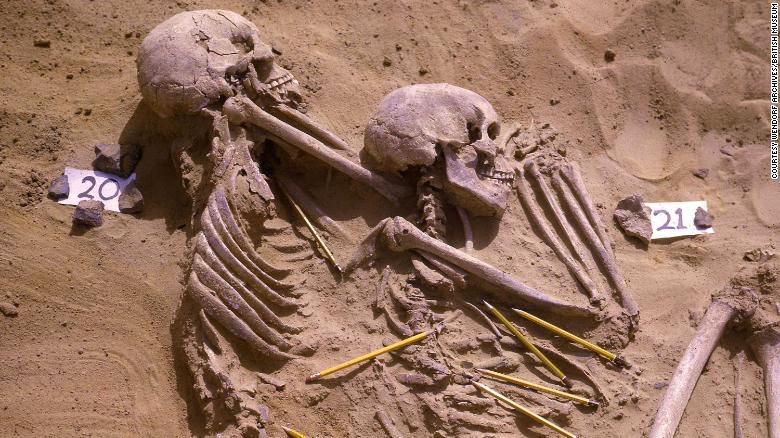
The 61 human skeletons unearthed in the Nile Valley in the 1960s in what is now Sudan have long been regarded as the earliest evidence of organized warfare between humans.
The remains uncovered at Jebel Sahaba, which are more than 13,000 years old, show injuries sustained as a result of brutal and intense violence mainly puncture wounds from weapons such as spears and arrows.
However, a new study published in the journal Scientific Reports that reexamined the remains using the latest scientific methods suggests that the group were not killed in a one-off massacre as previously thought. More likely they were killed during sporadic and recurrent violence that took place over several years and was probably triggered by major climatic and environmental changes during the period.
Isabelle Crevecoeur (right) and Marie‑Hélène Dias‑Meirinho (left) study the Jebel Sahaba human remains in the Egypt and Sudan department of the British Museum.
The researchers from France and the United Kingdom found healed injuries on the skeletons that hadn't been documented in previous studies on the remains suggesting there were multiple raids, ambushes and skirmishes within these people's lifetimes.
Everybody in what would have been a community of hunters, fishers and gatherers was a target for violence, with men, women and children affected in an indiscriminate manner, said Isabelle Crevecoeur, a researcher at the French National Centre for Scientific Research (CNRS) and the University of Bordeaux.
"The only difference is related to what might be close combat. Women have more parry fractures of the forearm and men more fractures of the hand. In a close combat event, women might more instinctively try to protect themselves (with arms) while men might fight more with their hands."
The children in the cemetery were more likely to have sustained blunt force trauma to the head.
And the projectile nature of the wounds suggested that the violence wasn't domestic or between members of the same community, she added.
The researchers revealed more than 100 new wounds both healed and unhealed on the skeletons and some of them had flakes from stone weapons still embedded in the bones.
The mark made by a projectile weapon such as stone spear or arrowhead on the surface of a hip bone.
Almost all the individuals had evidence of trauma, whether from bone fractures or puncture wounds from projectile weapons. Some 40% of the individuals had both healed and unhealed injuries, suggesting that violence was part of the fabric of life at that time.
They were also able to accurately date the skeletons to at least 13,400 years old through radiocarbon dating, making it the earliest known cemetery and example of interpersonal violence in the world.
She said there was no way to be sure about what people were fighting about as there are no written documents.
That said, the researchers believe that the conflict arose as rival groups that lived in the area competed for food and resources limited by dramatic changes in climate. Those changes took place between 11,000 and 20,000 years ago toward the end of a period known as the last glacial maximum, when ice sheets covered much of the Northern Hemisphere, disrupting the Earth's climate.
Sign up for CNN's Wonder Theory science newsletter. Explore the universe with news on fascinating discoveries, scientific advancements and more.
Crevecoeur said the Nile Valley might have been a refuge for different groups of humans that once lived across a wide area as a very arid climate drove them toward the river, where it would have been easier to find animals to hunt and fish. There was also evidence of very severe flooding of the Nile at this time, she added.
"These changes were not gradual at all. They had to survive these changes that were brutal," Crevecoeur said.
Comprehension
When were the skeletons first uncovered?
How many massacres did scientists once believe killed the people?
How long do scientists believe a war was?
What do scientists regard the skeletons as being the earliest example of?
What kind of weapons resulted in the death of the ancient people?
Vocabulary
- skeleton : An internal or external framework of bone, cartilage, or other rigid material supporting or containing the body of an animal.
- massacre : A random and brutal slaughter of people.
- Triggered : Caused an event or situation to happen or exist.
- Brutal : Savagely violent.
- Sustained : Continuing for an extended period or without interruption
